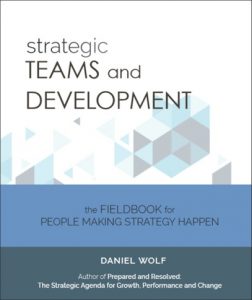High-Performance Strategic Teams
The essential advantage of strategic teams is the potential for better, smarter, stronger, faster performance. That may sound like a restatement of the obvious, however, it reflects some key development concerns. Who serves on high-performance teams? How do these teams become better than the sum of their individual parts? What enables, motivates and engages people on high-performance teams? Why do some teams maintain their high-performance track while other teams waver off-course? When should teams recharge, restructure, renew, reframe, or repower? These and other questions are part of the team design and leadership journey.
So far, so good … But what is the nature of a generative model for high-performance teams?
Teams are the product of enterprise design. Good design begins with context and attention to purpose. Not all teams are thoughtfully designed, and quite clearly, not all teams are thoughtfully assigned. Good team design matches resources to functions, priorities, needs, and challenges. Naturally, human capital is the key resource. But people operate with the benefit of advanced systems knowledge, practices, and other resources, including the capacity of other associates. Good design takes these factors into account, matching talent to tasks – and relationships.
High-performance teams are purpose-built and forged with practice. They are blessed and tested by situations that provide the kind of experience that sharpens them, and they are often lucky. They are well-drafted and well-coached, well-settled and well-traded.
From our research for Strategic Teams and Development, the readiness factor with high-performance teams is a key component, and a critical design factor that is rooted in culture and structure.
- What is our Expectation?
High-performance teams generate deep-set appreciation for the main challenge, the work to be done, the purpose of the team, the essence of the enterprise and its strategic agenda.
- What Kind of Everyday Thought and Behavior is Required?
High-performance teams have a mindset that serves, and a knack for problem solving, risk managing, decision making and forward planning, no matter the conditions, no matter the tensions.
- What Really Counts?
High-performance teams adhere to the strategic intentions and progress markers that matter most. They understand the match of talent and resolve that generates collective impact, time and again.
Woven into these descriptors are natural accountability, functional practices, process maturity, adaptive resources, the capacity to zoom-in and zoom-out, savvy communication, system strength and continuous learning in practice. High-performance teams deal well with challenges and constraints. They are stress-tolerant. They are especially resilient. They are passionate and compassionate. In most high-performance teams, we see leadership assets at every level, servant leadership in command roles, and a wide range of leadership persona established in functional, technical, and organizational roles … a most powerful form of diversity.
Design and Build with Purpose
High-performance teams are everywhere, and they are not necessarily the ones that are stacked with trophy individual talent. The match and balance of individual and team talent, for most organizations, may be more important than specific player/worker talent. That is why team design is so very, very important. What is the purpose of the team, near-term and long-term? Now, design and build your high-performance team accordingly, and with dispatch.
The ideas defined above are the subject of our new fieldbook entitled Strategic Teams and Development planned for release early next year. The fieldbook is designed as a resource for individuals and teams at every level of the enterprise. From every angle, Strategic Teams and Development speaks to the ideas that contribute to better, stronger, smarter, faster teams that are focused on results and on making strategy happen, taking care of today and getting ready for tomorrow.
Daniel Wolf is the President of Dewar Sloan, a consulting group with expertise in strategy and governance. He is the author of Strategic Teams and Development — as well as Prepared and Resolved: The Strategic Agenda for Growth, Performance and Change.






Sorry, the comment form is closed at this time.